Contemporary Business Economics Report: Demand and Supply Analysis
VerifiedAdded on 2022/12/15
|12
|2800
|280
Report
AI Summary
This report delves into contemporary business economics, focusing on demand and supply analysis. Task 1 examines the law of demand and supply, illustrating movements along the curves and factors causing changes, using diagrams. It explores how price, quantity, and other factors interact within a microeconomic framework. Task 2 compares and contrasts emerging economic theories and models of the 21st century with those of the 20th century, relating both to modern business practices. The report discusses the evolution of economic thought, including the impact of financial inequalities, market power, and digital economies. It highlights the shift from classical economics to contemporary models and their influence on business strategies. The report also considers the impact of the financial crisis of 2008 and its implications for market dynamics. The report aims to provide insights into how businesses can navigate the complexities of modern economic environments.
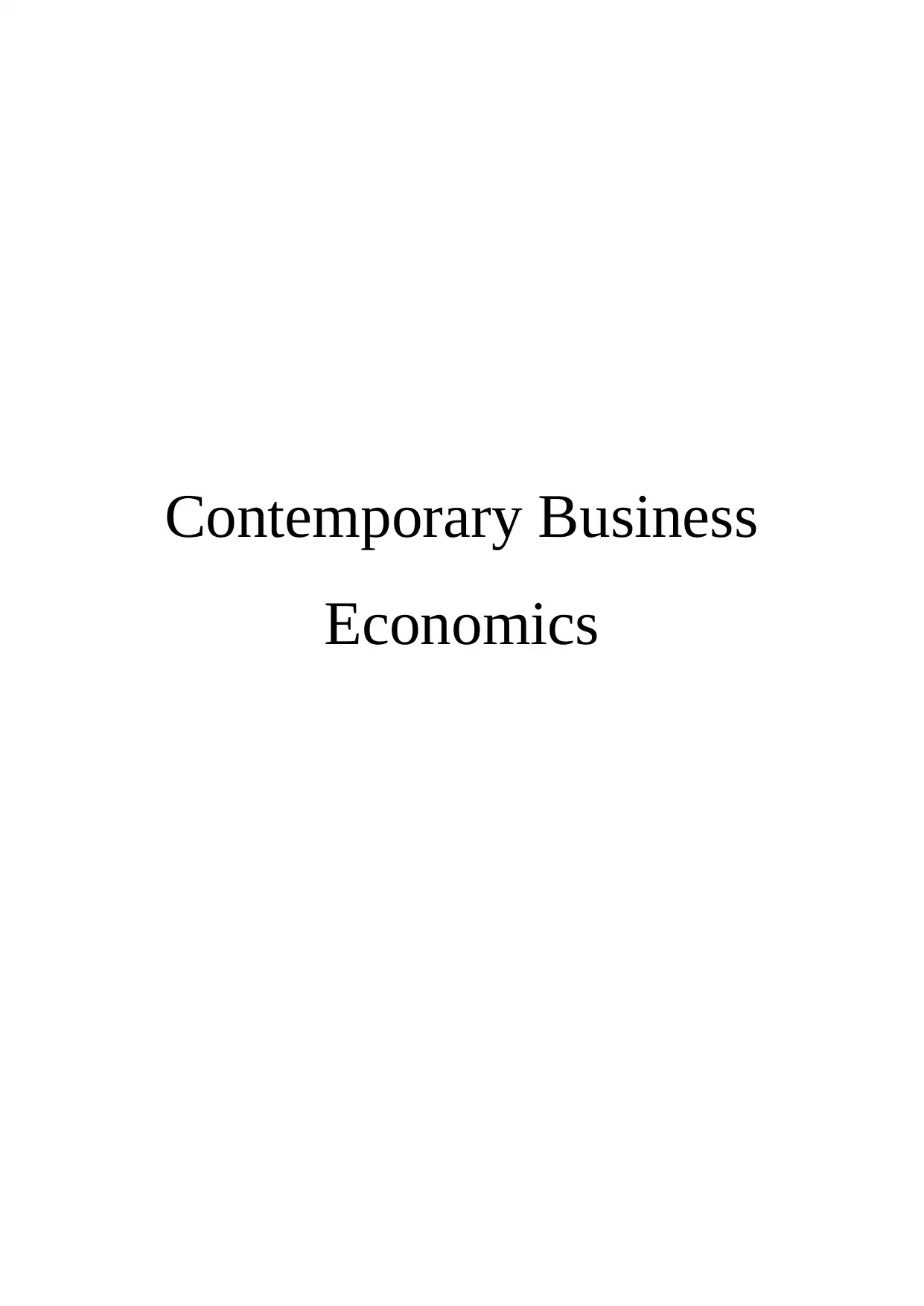
Contemporary Business
Economics
Economics
Paraphrase This Document
Need a fresh take? Get an instant paraphrase of this document with our AI Paraphraser

Contents
Introduction................................................................................................................................3
Task 1.........................................................................................................................................3
What is the law of demand? Discuss movement and changes in demand curves in addition
with the factors.......................................................................................................................3
What are the law of supply, its movement along the supply curve and the changes in the
supply curve along with the factors?......................................................................................6
Task 2.........................................................................................................................................8
Give the relation among emerging theories and models in 21st century contemporary
economies with those of the 20th century, and to relate the two of these modern business
practices..................................................................................................................................8
Conclusion..................................................................................................................................9
Introduction................................................................................................................................3
Task 1.........................................................................................................................................3
What is the law of demand? Discuss movement and changes in demand curves in addition
with the factors.......................................................................................................................3
What are the law of supply, its movement along the supply curve and the changes in the
supply curve along with the factors?......................................................................................6
Task 2.........................................................................................................................................8
Give the relation among emerging theories and models in 21st century contemporary
economies with those of the 20th century, and to relate the two of these modern business
practices..................................................................................................................................8
Conclusion..................................................................................................................................9
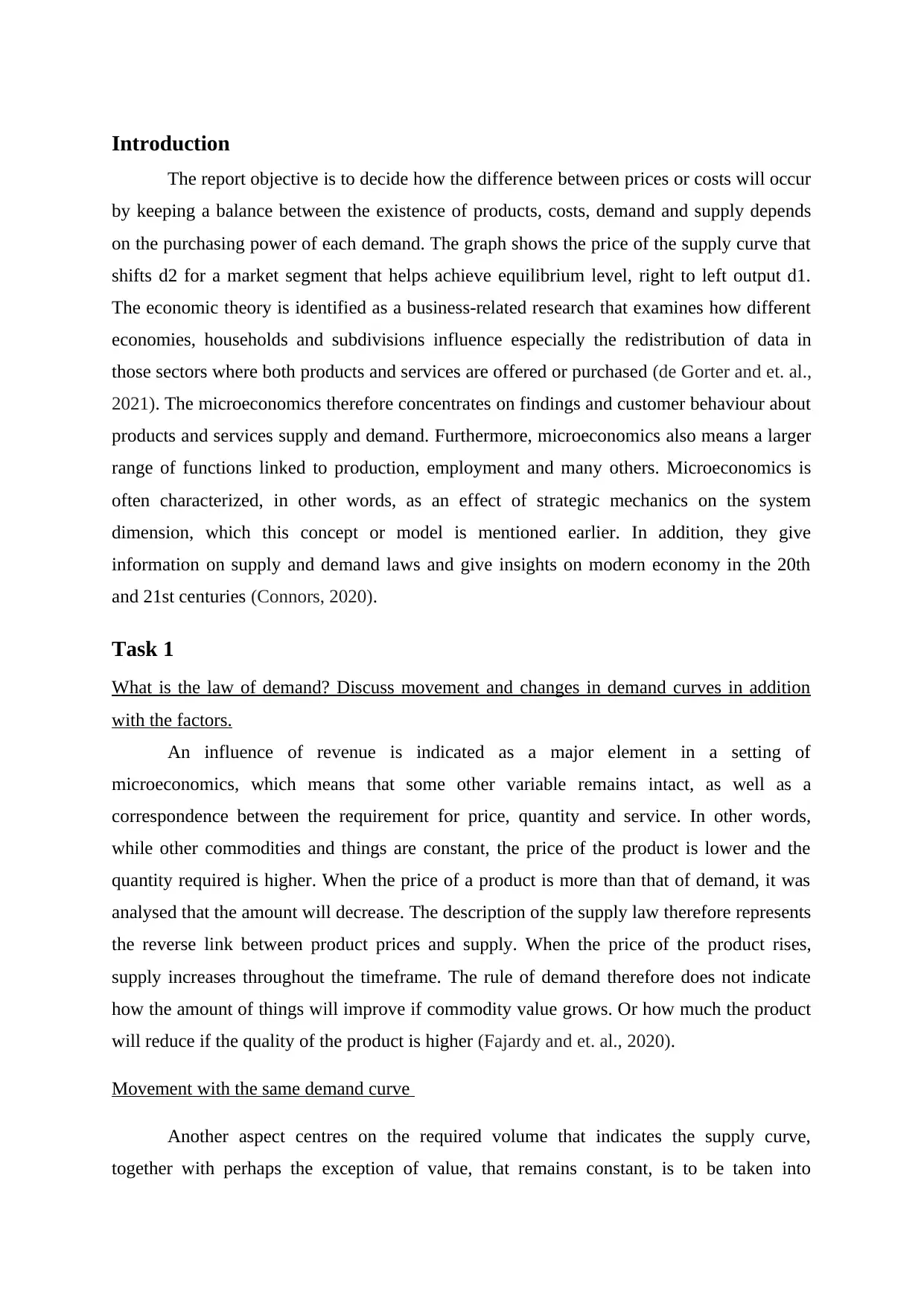
Introduction
The report objective is to decide how the difference between prices or costs will occur
by keeping a balance between the existence of products, costs, demand and supply depends
on the purchasing power of each demand. The graph shows the price of the supply curve that
shifts d2 for a market segment that helps achieve equilibrium level, right to left output d1.
The economic theory is identified as a business-related research that examines how different
economies, households and subdivisions influence especially the redistribution of data in
those sectors where both products and services are offered or purchased (de Gorter and et. al.,
2021). The microeconomics therefore concentrates on findings and customer behaviour about
products and services supply and demand. Furthermore, microeconomics also means a larger
range of functions linked to production, employment and many others. Microeconomics is
often characterized, in other words, as an effect of strategic mechanics on the system
dimension, which this concept or model is mentioned earlier. In addition, they give
information on supply and demand laws and give insights on modern economy in the 20th
and 21st centuries (Connors, 2020).
Task 1
What is the law of demand? Discuss movement and changes in demand curves in addition
with the factors.
An influence of revenue is indicated as a major element in a setting of
microeconomics, which means that some other variable remains intact, as well as a
correspondence between the requirement for price, quantity and service. In other words,
while other commodities and things are constant, the price of the product is lower and the
quantity required is higher. When the price of a product is more than that of demand, it was
analysed that the amount will decrease. The description of the supply law therefore represents
the reverse link between product prices and supply. When the price of the product rises,
supply increases throughout the timeframe. The rule of demand therefore does not indicate
how the amount of things will improve if commodity value grows. Or how much the product
will reduce if the quality of the product is higher (Fajardy and et. al., 2020).
Movement with the same demand curve
Another aspect centres on the required volume that indicates the supply curve,
together with perhaps the exception of value, that remains constant, is to be taken into
The report objective is to decide how the difference between prices or costs will occur
by keeping a balance between the existence of products, costs, demand and supply depends
on the purchasing power of each demand. The graph shows the price of the supply curve that
shifts d2 for a market segment that helps achieve equilibrium level, right to left output d1.
The economic theory is identified as a business-related research that examines how different
economies, households and subdivisions influence especially the redistribution of data in
those sectors where both products and services are offered or purchased (de Gorter and et. al.,
2021). The microeconomics therefore concentrates on findings and customer behaviour about
products and services supply and demand. Furthermore, microeconomics also means a larger
range of functions linked to production, employment and many others. Microeconomics is
often characterized, in other words, as an effect of strategic mechanics on the system
dimension, which this concept or model is mentioned earlier. In addition, they give
information on supply and demand laws and give insights on modern economy in the 20th
and 21st centuries (Connors, 2020).
Task 1
What is the law of demand? Discuss movement and changes in demand curves in addition
with the factors.
An influence of revenue is indicated as a major element in a setting of
microeconomics, which means that some other variable remains intact, as well as a
correspondence between the requirement for price, quantity and service. In other words,
while other commodities and things are constant, the price of the product is lower and the
quantity required is higher. When the price of a product is more than that of demand, it was
analysed that the amount will decrease. The description of the supply law therefore represents
the reverse link between product prices and supply. When the price of the product rises,
supply increases throughout the timeframe. The rule of demand therefore does not indicate
how the amount of things will improve if commodity value grows. Or how much the product
will reduce if the quality of the product is higher (Fajardy and et. al., 2020).
Movement with the same demand curve
Another aspect centres on the required volume that indicates the supply curve,
together with perhaps the exception of value, that remains constant, is to be taken into
⊘ This is a preview!⊘
Do you want full access?
Subscribe today to unlock all pages.

Trusted by 1+ million students worldwide
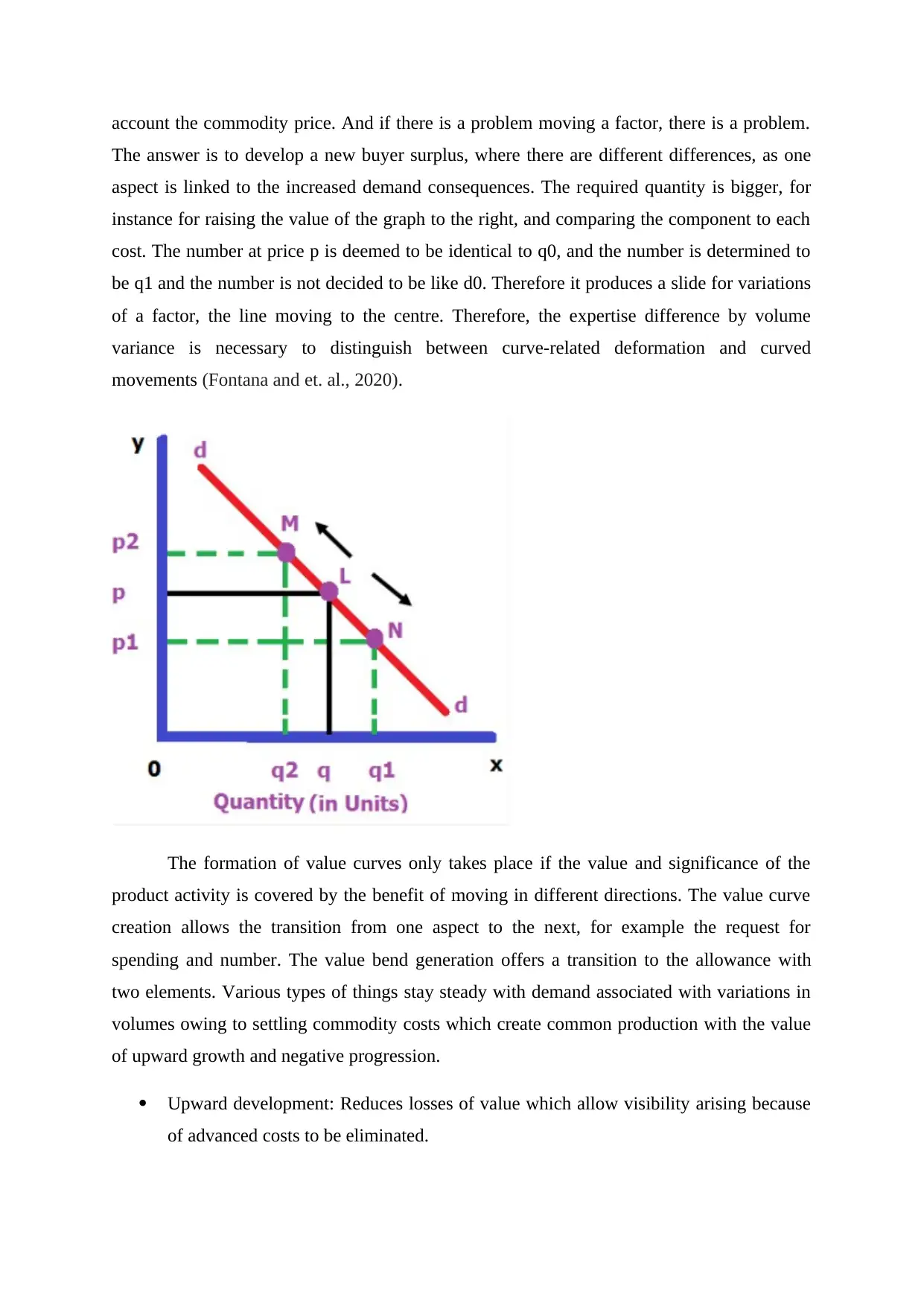
account the commodity price. And if there is a problem moving a factor, there is a problem.
The answer is to develop a new buyer surplus, where there are different differences, as one
aspect is linked to the increased demand consequences. The required quantity is bigger, for
instance for raising the value of the graph to the right, and comparing the component to each
cost. The number at price p is deemed to be identical to q0, and the number is determined to
be q1 and the number is not decided to be like d0. Therefore it produces a slide for variations
of a factor, the line moving to the centre. Therefore, the expertise difference by volume
variance is necessary to distinguish between curve-related deformation and curved
movements (Fontana and et. al., 2020).
The formation of value curves only takes place if the value and significance of the
product activity is covered by the benefit of moving in different directions. The value curve
creation allows the transition from one aspect to the next, for example the request for
spending and number. The value bend generation offers a transition to the allowance with
two elements. Various types of things stay steady with demand associated with variations in
volumes owing to settling commodity costs which create common production with the value
of upward growth and negative progression.
Upward development: Reduces losses of value which allow visibility arising because
of advanced costs to be eliminated.
The answer is to develop a new buyer surplus, where there are different differences, as one
aspect is linked to the increased demand consequences. The required quantity is bigger, for
instance for raising the value of the graph to the right, and comparing the component to each
cost. The number at price p is deemed to be identical to q0, and the number is determined to
be q1 and the number is not decided to be like d0. Therefore it produces a slide for variations
of a factor, the line moving to the centre. Therefore, the expertise difference by volume
variance is necessary to distinguish between curve-related deformation and curved
movements (Fontana and et. al., 2020).
The formation of value curves only takes place if the value and significance of the
product activity is covered by the benefit of moving in different directions. The value curve
creation allows the transition from one aspect to the next, for example the request for
spending and number. The value bend generation offers a transition to the allowance with
two elements. Various types of things stay steady with demand associated with variations in
volumes owing to settling commodity costs which create common production with the value
of upward growth and negative progression.
Upward development: Reduces losses of value which allow visibility arising because
of advanced costs to be eliminated.
Paraphrase This Document
Need a fresh take? Get an instant paraphrase of this document with our AI Paraphraser
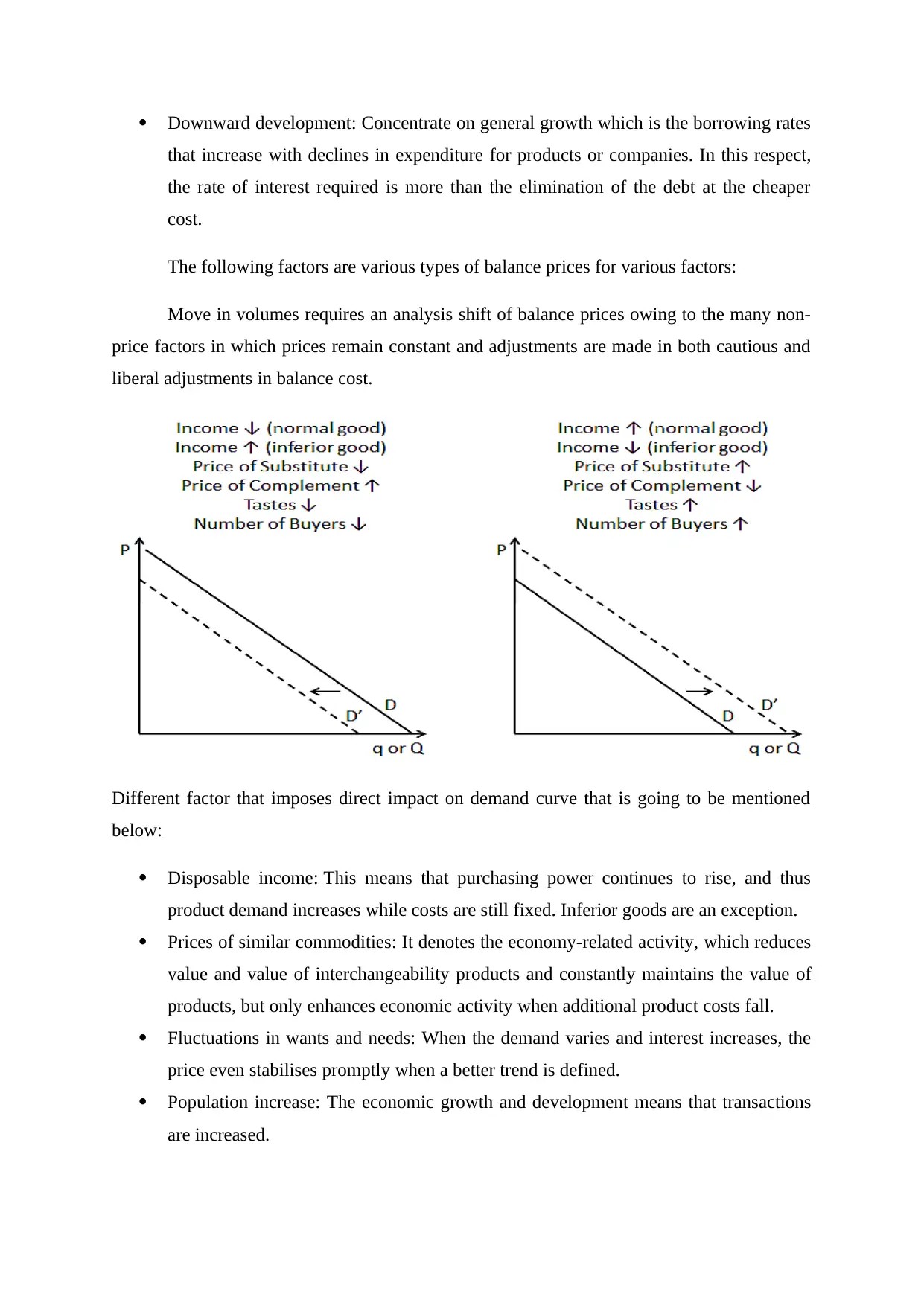
Downward development: Concentrate on general growth which is the borrowing rates
that increase with declines in expenditure for products or companies. In this respect,
the rate of interest required is more than the elimination of the debt at the cheaper
cost.
The following factors are various types of balance prices for various factors:
Move in volumes requires an analysis shift of balance prices owing to the many non-
price factors in which prices remain constant and adjustments are made in both cautious and
liberal adjustments in balance cost.
Different factor that imposes direct impact on demand curve that is going to be mentioned
below:
Disposable income: This means that purchasing power continues to rise, and thus
product demand increases while costs are still fixed. Inferior goods are an exception.
Prices of similar commodities: It denotes the economy-related activity, which reduces
value and value of interchangeability products and constantly maintains the value of
products, but only enhances economic activity when additional product costs fall.
Fluctuations in wants and needs: When the demand varies and interest increases, the
price even stabilises promptly when a better trend is defined.
Population increase: The economic growth and development means that transactions
are increased.
that increase with declines in expenditure for products or companies. In this respect,
the rate of interest required is more than the elimination of the debt at the cheaper
cost.
The following factors are various types of balance prices for various factors:
Move in volumes requires an analysis shift of balance prices owing to the many non-
price factors in which prices remain constant and adjustments are made in both cautious and
liberal adjustments in balance cost.
Different factor that imposes direct impact on demand curve that is going to be mentioned
below:
Disposable income: This means that purchasing power continues to rise, and thus
product demand increases while costs are still fixed. Inferior goods are an exception.
Prices of similar commodities: It denotes the economy-related activity, which reduces
value and value of interchangeability products and constantly maintains the value of
products, but only enhances economic activity when additional product costs fall.
Fluctuations in wants and needs: When the demand varies and interest increases, the
price even stabilises promptly when a better trend is defined.
Population increase: The economic growth and development means that transactions
are increased.

Special influences: The transport industry has special implications, both in the short
and long term, on the safety expectation of consumers for shifting prices.
In other conditions the demand curve shifts, there are all kinds of variances. If demand at the
price level increases then it means that the demand curve is moving in the correct direction
and if the price falls, the price of the market shifts to the left (Game and et. al., 2020).
What are the law of supply, its movement along the supply curve and the changes in the
supply curve along with the factors?
Law of supply: A supply of the curve is determined as a decent presentation and affordable
service. The overall demand conceived according to the mathematical model is dependent on
the price as a particular variable on the monetary level of the items. The association between
performances is vital or advantageous and costs are found as an explanation of increased
supply trends. This means that the producer concentrates on the selling of items at high prices
as a way of boosting profits, but the amount provided will grow in specified time periods.
The provided quantity is increased. For instance, the production plan is worth $1 between 100
units, and also when the price for purchases is $2 which allows a company generating to
increase the production price to 140 components a day. The supply curve is therefore
considered a steep value because of the supply rule. According to this law, if the quality of
the products and services are increasing in any way and the value produced afterwards is
modified, and vice versa (Harrison and et. al., 2020).
Movement along the supply curve:
If variations in supply volumes are related to price improvement and decrease while
maintaining all types of variable, they are constant and shift to supply quantity. There is
established that it is a link between price and quantity, which means that volume-related
production grows with price growth and product cost decreases. It means positive
relationships between diverse people that are discussed below:
and long term, on the safety expectation of consumers for shifting prices.
In other conditions the demand curve shifts, there are all kinds of variances. If demand at the
price level increases then it means that the demand curve is moving in the correct direction
and if the price falls, the price of the market shifts to the left (Game and et. al., 2020).
What are the law of supply, its movement along the supply curve and the changes in the
supply curve along with the factors?
Law of supply: A supply of the curve is determined as a decent presentation and affordable
service. The overall demand conceived according to the mathematical model is dependent on
the price as a particular variable on the monetary level of the items. The association between
performances is vital or advantageous and costs are found as an explanation of increased
supply trends. This means that the producer concentrates on the selling of items at high prices
as a way of boosting profits, but the amount provided will grow in specified time periods.
The provided quantity is increased. For instance, the production plan is worth $1 between 100
units, and also when the price for purchases is $2 which allows a company generating to
increase the production price to 140 components a day. The supply curve is therefore
considered a steep value because of the supply rule. According to this law, if the quality of
the products and services are increasing in any way and the value produced afterwards is
modified, and vice versa (Harrison and et. al., 2020).
Movement along the supply curve:
If variations in supply volumes are related to price improvement and decrease while
maintaining all types of variable, they are constant and shift to supply quantity. There is
established that it is a link between price and quantity, which means that volume-related
production grows with price growth and product cost decreases. It means positive
relationships between diverse people that are discussed below:
⊘ This is a preview!⊘
Do you want full access?
Subscribe today to unlock all pages.

Trusted by 1+ million students worldwide
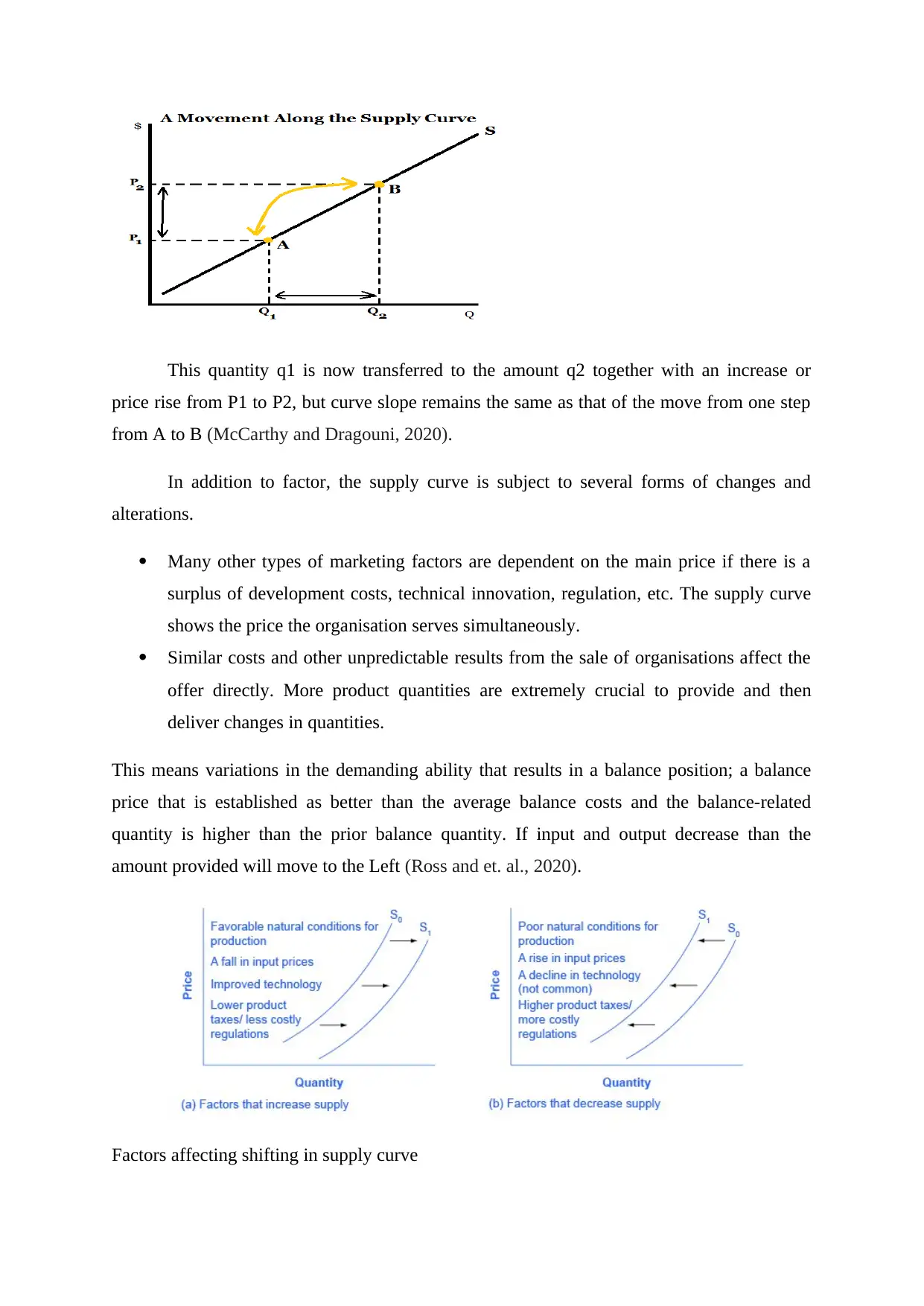
This quantity q1 is now transferred to the amount q2 together with an increase or
price rise from P1 to P2, but curve slope remains the same as that of the move from one step
from A to B (McCarthy and Dragouni, 2020).
In addition to factor, the supply curve is subject to several forms of changes and
alterations.
Many other types of marketing factors are dependent on the main price if there is a
surplus of development costs, technical innovation, regulation, etc. The supply curve
shows the price the organisation serves simultaneously.
Similar costs and other unpredictable results from the sale of organisations affect the
offer directly. More product quantities are extremely crucial to provide and then
deliver changes in quantities.
This means variations in the demanding ability that results in a balance position; a balance
price that is established as better than the average balance costs and the balance-related
quantity is higher than the prior balance quantity. If input and output decrease than the
amount provided will move to the Left (Ross and et. al., 2020).
Factors affecting shifting in supply curve
price rise from P1 to P2, but curve slope remains the same as that of the move from one step
from A to B (McCarthy and Dragouni, 2020).
In addition to factor, the supply curve is subject to several forms of changes and
alterations.
Many other types of marketing factors are dependent on the main price if there is a
surplus of development costs, technical innovation, regulation, etc. The supply curve
shows the price the organisation serves simultaneously.
Similar costs and other unpredictable results from the sale of organisations affect the
offer directly. More product quantities are extremely crucial to provide and then
deliver changes in quantities.
This means variations in the demanding ability that results in a balance position; a balance
price that is established as better than the average balance costs and the balance-related
quantity is higher than the prior balance quantity. If input and output decrease than the
amount provided will move to the Left (Ross and et. al., 2020).
Factors affecting shifting in supply curve
Paraphrase This Document
Need a fresh take? Get an instant paraphrase of this document with our AI Paraphraser
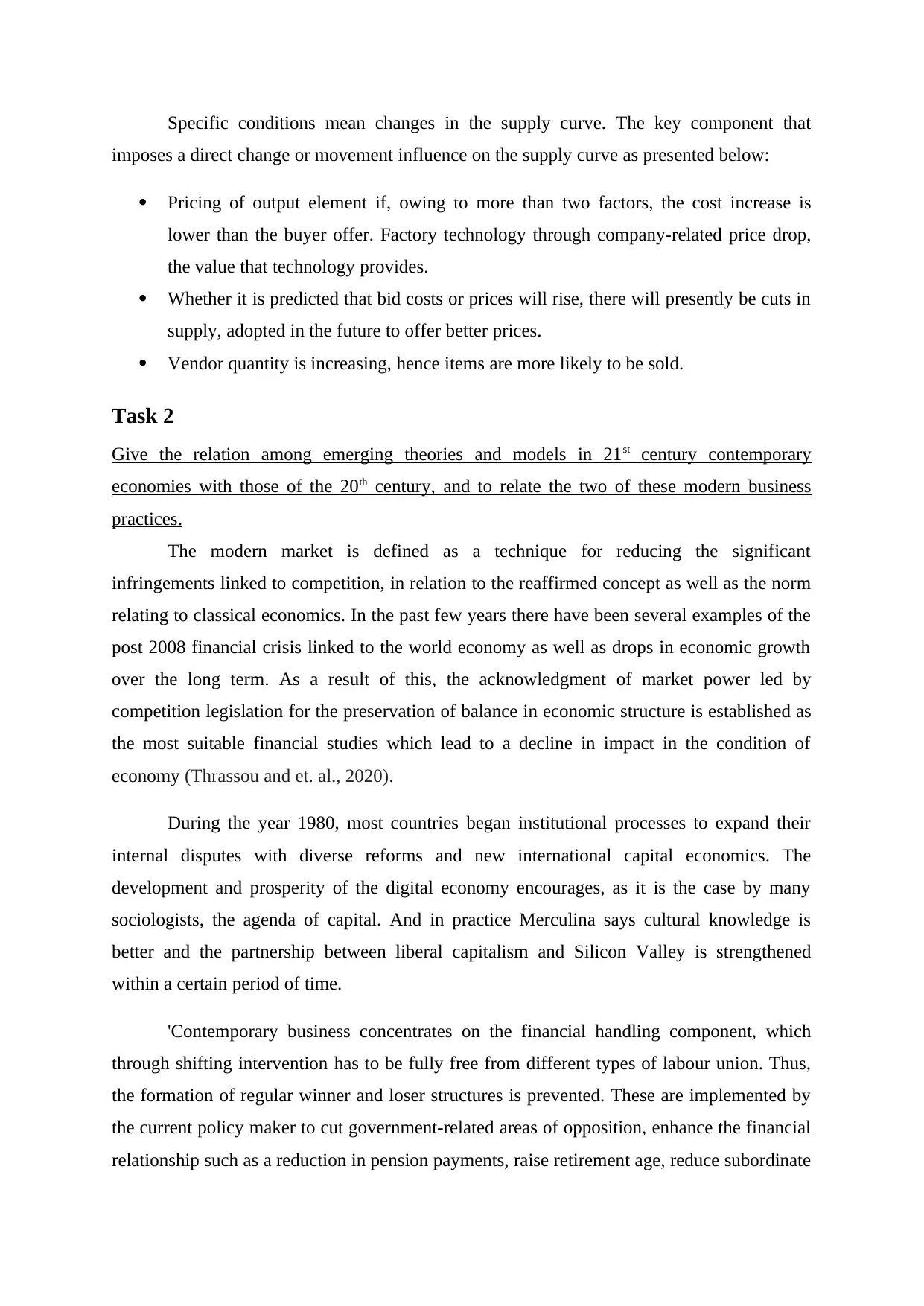
Specific conditions mean changes in the supply curve. The key component that
imposes a direct change or movement influence on the supply curve as presented below:
Pricing of output element if, owing to more than two factors, the cost increase is
lower than the buyer offer. Factory technology through company-related price drop,
the value that technology provides.
Whether it is predicted that bid costs or prices will rise, there will presently be cuts in
supply, adopted in the future to offer better prices.
Vendor quantity is increasing, hence items are more likely to be sold.
Task 2
Give the relation among emerging theories and models in 21st century contemporary
economies with those of the 20th century, and to relate the two of these modern business
practices.
The modern market is defined as a technique for reducing the significant
infringements linked to competition, in relation to the reaffirmed concept as well as the norm
relating to classical economics. In the past few years there have been several examples of the
post 2008 financial crisis linked to the world economy as well as drops in economic growth
over the long term. As a result of this, the acknowledgment of market power led by
competition legislation for the preservation of balance in economic structure is established as
the most suitable financial studies which lead to a decline in impact in the condition of
economy (Thrassou and et. al., 2020).
During the year 1980, most countries began institutional processes to expand their
internal disputes with diverse reforms and new international capital economics. The
development and prosperity of the digital economy encourages, as it is the case by many
sociologists, the agenda of capital. And in practice Merculina says cultural knowledge is
better and the partnership between liberal capitalism and Silicon Valley is strengthened
within a certain period of time.
'Contemporary business concentrates on the financial handling component, which
through shifting intervention has to be fully free from different types of labour union. Thus,
the formation of regular winner and loser structures is prevented. These are implemented by
the current policy maker to cut government-related areas of opposition, enhance the financial
relationship such as a reduction in pension payments, raise retirement age, reduce subordinate
imposes a direct change or movement influence on the supply curve as presented below:
Pricing of output element if, owing to more than two factors, the cost increase is
lower than the buyer offer. Factory technology through company-related price drop,
the value that technology provides.
Whether it is predicted that bid costs or prices will rise, there will presently be cuts in
supply, adopted in the future to offer better prices.
Vendor quantity is increasing, hence items are more likely to be sold.
Task 2
Give the relation among emerging theories and models in 21st century contemporary
economies with those of the 20th century, and to relate the two of these modern business
practices.
The modern market is defined as a technique for reducing the significant
infringements linked to competition, in relation to the reaffirmed concept as well as the norm
relating to classical economics. In the past few years there have been several examples of the
post 2008 financial crisis linked to the world economy as well as drops in economic growth
over the long term. As a result of this, the acknowledgment of market power led by
competition legislation for the preservation of balance in economic structure is established as
the most suitable financial studies which lead to a decline in impact in the condition of
economy (Thrassou and et. al., 2020).
During the year 1980, most countries began institutional processes to expand their
internal disputes with diverse reforms and new international capital economics. The
development and prosperity of the digital economy encourages, as it is the case by many
sociologists, the agenda of capital. And in practice Merculina says cultural knowledge is
better and the partnership between liberal capitalism and Silicon Valley is strengthened
within a certain period of time.
'Contemporary business concentrates on the financial handling component, which
through shifting intervention has to be fully free from different types of labour union. Thus,
the formation of regular winner and loser structures is prevented. These are implemented by
the current policy maker to cut government-related areas of opposition, enhance the financial
relationship such as a reduction in pension payments, raise retirement age, reduce subordinate
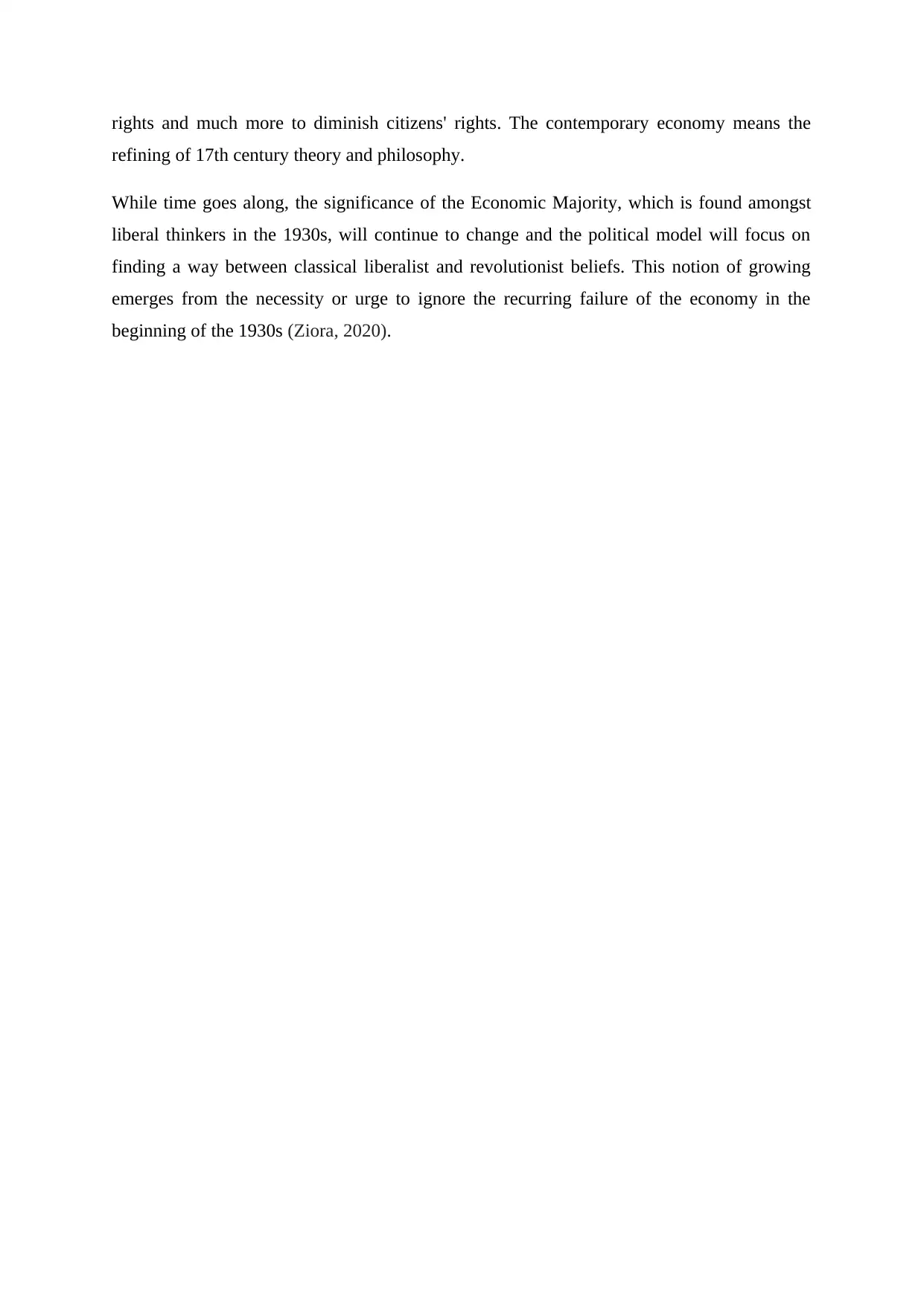
rights and much more to diminish citizens' rights. The contemporary economy means the
refining of 17th century theory and philosophy.
While time goes along, the significance of the Economic Majority, which is found amongst
liberal thinkers in the 1930s, will continue to change and the political model will focus on
finding a way between classical liberalist and revolutionist beliefs. This notion of growing
emerges from the necessity or urge to ignore the recurring failure of the economy in the
beginning of the 1930s (Ziora, 2020).
refining of 17th century theory and philosophy.
While time goes along, the significance of the Economic Majority, which is found amongst
liberal thinkers in the 1930s, will continue to change and the political model will focus on
finding a way between classical liberalist and revolutionist beliefs. This notion of growing
emerges from the necessity or urge to ignore the recurring failure of the economy in the
beginning of the 1930s (Ziora, 2020).
⊘ This is a preview!⊘
Do you want full access?
Subscribe today to unlock all pages.

Trusted by 1+ million students worldwide
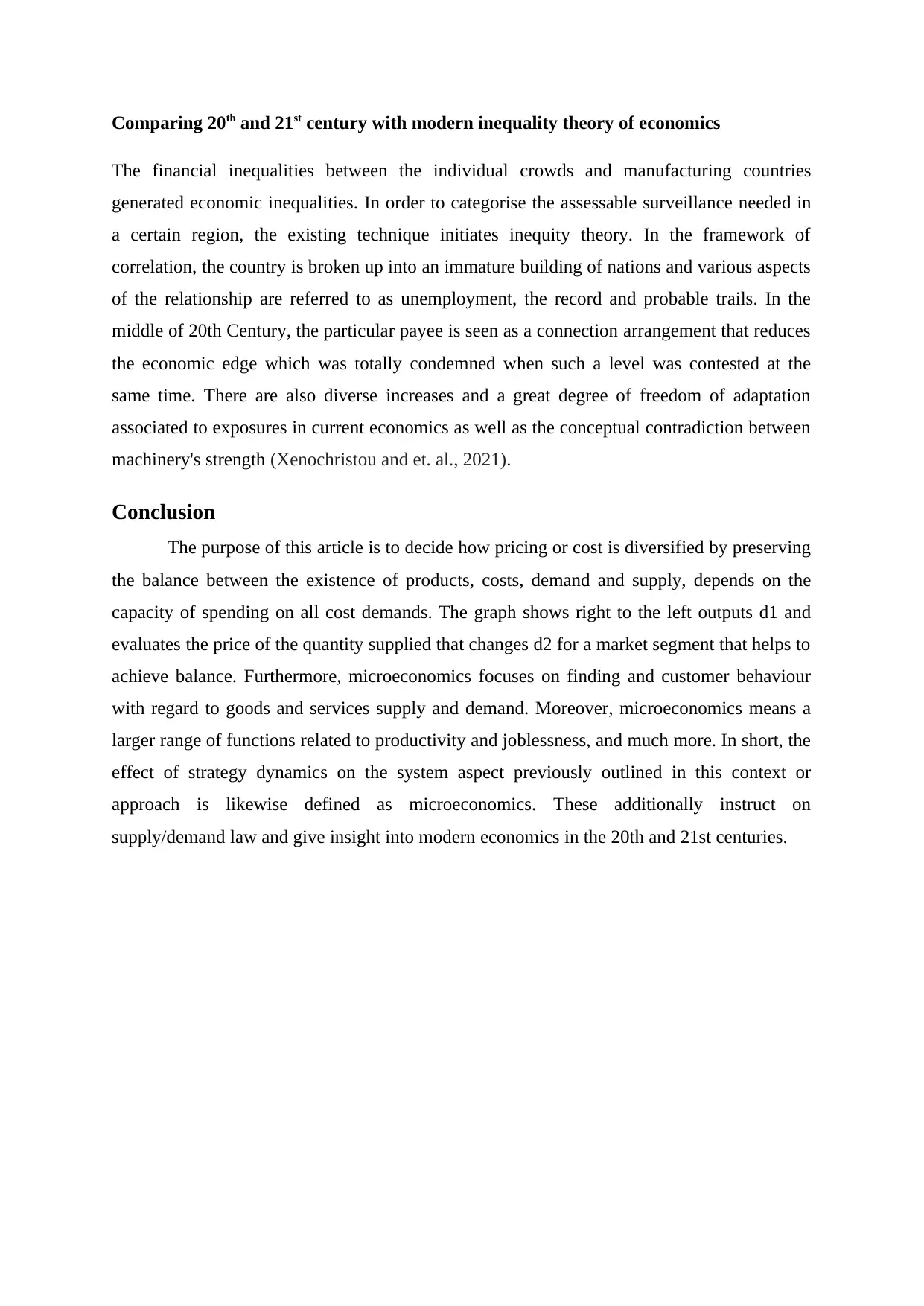
Comparing 20th and 21st century with modern inequality theory of economics
The financial inequalities between the individual crowds and manufacturing countries
generated economic inequalities. In order to categorise the assessable surveillance needed in
a certain region, the existing technique initiates inequity theory. In the framework of
correlation, the country is broken up into an immature building of nations and various aspects
of the relationship are referred to as unemployment, the record and probable trails. In the
middle of 20th Century, the particular payee is seen as a connection arrangement that reduces
the economic edge which was totally condemned when such a level was contested at the
same time. There are also diverse increases and a great degree of freedom of adaptation
associated to exposures in current economics as well as the conceptual contradiction between
machinery's strength (Xenochristou and et. al., 2021).
Conclusion
The purpose of this article is to decide how pricing or cost is diversified by preserving
the balance between the existence of products, costs, demand and supply, depends on the
capacity of spending on all cost demands. The graph shows right to the left outputs d1 and
evaluates the price of the quantity supplied that changes d2 for a market segment that helps to
achieve balance. Furthermore, microeconomics focuses on finding and customer behaviour
with regard to goods and services supply and demand. Moreover, microeconomics means a
larger range of functions related to productivity and joblessness, and much more. In short, the
effect of strategy dynamics on the system aspect previously outlined in this context or
approach is likewise defined as microeconomics. These additionally instruct on
supply/demand law and give insight into modern economics in the 20th and 21st centuries.
The financial inequalities between the individual crowds and manufacturing countries
generated economic inequalities. In order to categorise the assessable surveillance needed in
a certain region, the existing technique initiates inequity theory. In the framework of
correlation, the country is broken up into an immature building of nations and various aspects
of the relationship are referred to as unemployment, the record and probable trails. In the
middle of 20th Century, the particular payee is seen as a connection arrangement that reduces
the economic edge which was totally condemned when such a level was contested at the
same time. There are also diverse increases and a great degree of freedom of adaptation
associated to exposures in current economics as well as the conceptual contradiction between
machinery's strength (Xenochristou and et. al., 2021).
Conclusion
The purpose of this article is to decide how pricing or cost is diversified by preserving
the balance between the existence of products, costs, demand and supply, depends on the
capacity of spending on all cost demands. The graph shows right to the left outputs d1 and
evaluates the price of the quantity supplied that changes d2 for a market segment that helps to
achieve balance. Furthermore, microeconomics focuses on finding and customer behaviour
with regard to goods and services supply and demand. Moreover, microeconomics means a
larger range of functions related to productivity and joblessness, and much more. In short, the
effect of strategy dynamics on the system aspect previously outlined in this context or
approach is likewise defined as microeconomics. These additionally instruct on
supply/demand law and give insight into modern economics in the 20th and 21st centuries.
Paraphrase This Document
Need a fresh take? Get an instant paraphrase of this document with our AI Paraphraser

References
Books and Journals
Akpan, I.J., 2020. Scientometric evaluation and visual analytics of the scientific literature
production on entrepreneurship, small business ventures, and innovation. Journal of Small
Business & Entrepreneurship, pp.1-29.
Bruckmeier, K., 2020. Environmental Economics: Orthodox Perspectives. In Economics and
Sustainability (pp. 187-238). Palgrave Macmillan, Cham.
Cassetta, E., Monarca, U., Dileo, I., Di Berardino, C. and Pini, M., 2020. The relationship
between digital technologies and internationalisation. Evidence from Italian SMEs. Industry
and Innovation, 27(4), pp.311-339.
Dargahi, H. and Beiranvand, A., 2020. Determinants of Property Crime in Iran With
Emphasis on Business Cycles and Social Damages. Journal of Applied Economics Studies in
Iran, 9(35), pp.127-153.
Frid-Nielsen, S.S. and Jensen, M.D., 2020. Maps of Behavioural Economics: Evidence from
the Field. Journal of Interdisciplinary Economics, p.0260107920925675.
Helmold, M., Dathe, T., Hummel, F., Terry, B. and Pieper, J., 2020. Successful International
Negotiations. Springer International Publishing.
King, M. and Kay, J., 2020. Radical uncertainty: Decision-making for an unknowable future.
Hachette UK.
Loosemore, M., Alkilani, S. and Mathenge, R., 2020. The risks of and barriers to social
procurement in construction: a supply chain perspective. Construction Management and
Economics, 38(6), pp.552-569.
Books and Journals
Akpan, I.J., 2020. Scientometric evaluation and visual analytics of the scientific literature
production on entrepreneurship, small business ventures, and innovation. Journal of Small
Business & Entrepreneurship, pp.1-29.
Bruckmeier, K., 2020. Environmental Economics: Orthodox Perspectives. In Economics and
Sustainability (pp. 187-238). Palgrave Macmillan, Cham.
Cassetta, E., Monarca, U., Dileo, I., Di Berardino, C. and Pini, M., 2020. The relationship
between digital technologies and internationalisation. Evidence from Italian SMEs. Industry
and Innovation, 27(4), pp.311-339.
Dargahi, H. and Beiranvand, A., 2020. Determinants of Property Crime in Iran With
Emphasis on Business Cycles and Social Damages. Journal of Applied Economics Studies in
Iran, 9(35), pp.127-153.
Frid-Nielsen, S.S. and Jensen, M.D., 2020. Maps of Behavioural Economics: Evidence from
the Field. Journal of Interdisciplinary Economics, p.0260107920925675.
Helmold, M., Dathe, T., Hummel, F., Terry, B. and Pieper, J., 2020. Successful International
Negotiations. Springer International Publishing.
King, M. and Kay, J., 2020. Radical uncertainty: Decision-making for an unknowable future.
Hachette UK.
Loosemore, M., Alkilani, S. and Mathenge, R., 2020. The risks of and barriers to social
procurement in construction: a supply chain perspective. Construction Management and
Economics, 38(6), pp.552-569.
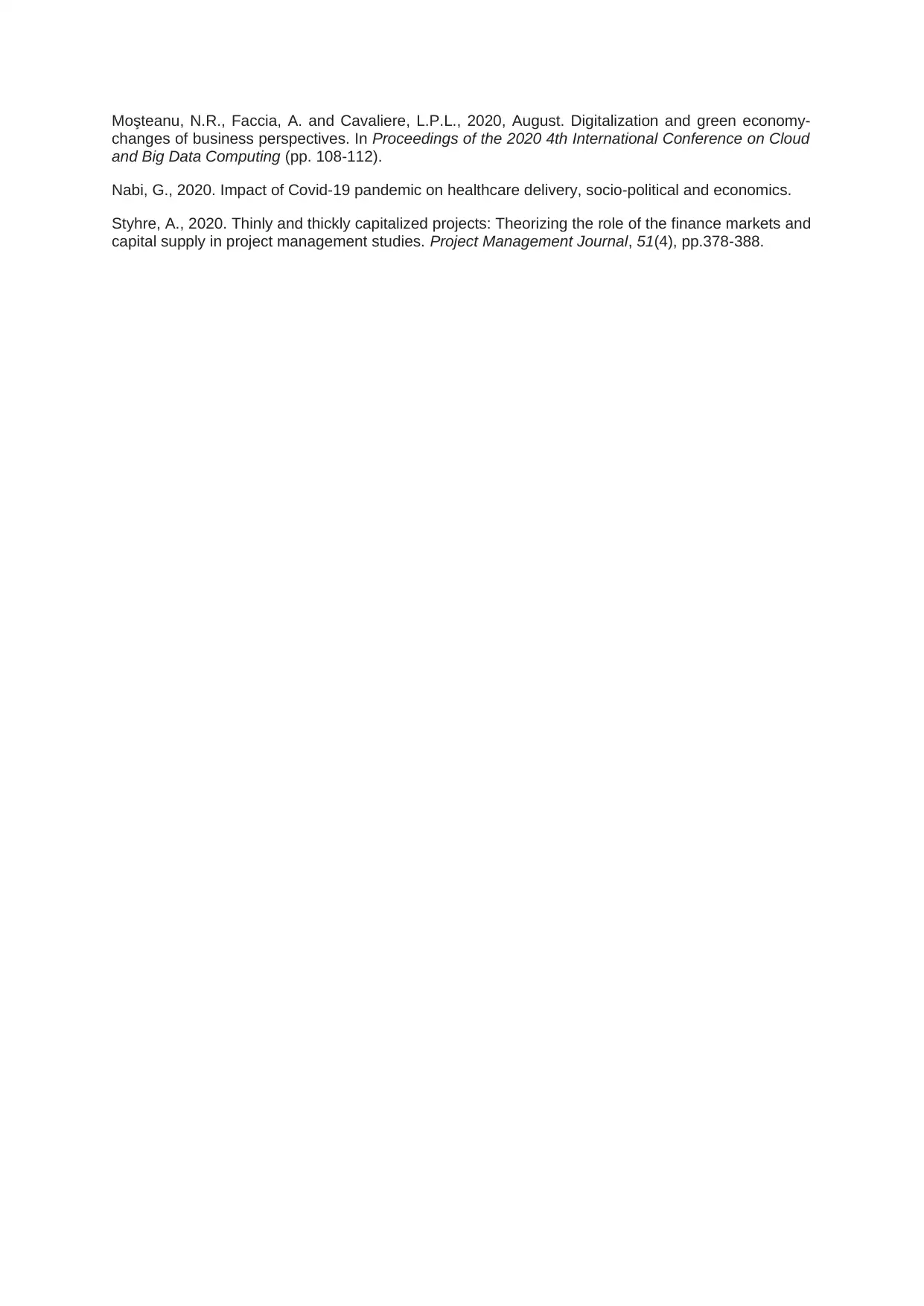
Moşteanu, N.R., Faccia, A. and Cavaliere, L.P.L., 2020, August. Digitalization and green economy-
changes of business perspectives. In Proceedings of the 2020 4th International Conference on Cloud
and Big Data Computing (pp. 108-112).
Nabi, G., 2020. Impact of Covid-19 pandemic on healthcare delivery, socio-political and economics.
Styhre, A., 2020. Thinly and thickly capitalized projects: Theorizing the role of the finance markets and
capital supply in project management studies. Project Management Journal, 51(4), pp.378-388.
changes of business perspectives. In Proceedings of the 2020 4th International Conference on Cloud
and Big Data Computing (pp. 108-112).
Nabi, G., 2020. Impact of Covid-19 pandemic on healthcare delivery, socio-political and economics.
Styhre, A., 2020. Thinly and thickly capitalized projects: Theorizing the role of the finance markets and
capital supply in project management studies. Project Management Journal, 51(4), pp.378-388.
⊘ This is a preview!⊘
Do you want full access?
Subscribe today to unlock all pages.

Trusted by 1+ million students worldwide
1 out of 12
Related Documents
Your All-in-One AI-Powered Toolkit for Academic Success.
+13062052269
info@desklib.com
Available 24*7 on WhatsApp / Email
![[object Object]](/_next/static/media/star-bottom.7253800d.svg)
Unlock your academic potential
Copyright © 2020–2025 A2Z Services. All Rights Reserved. Developed and managed by ZUCOL.





